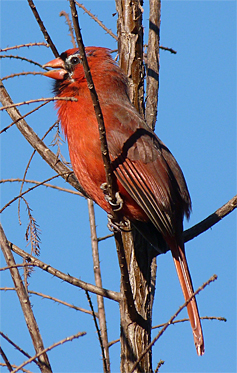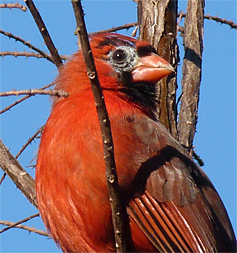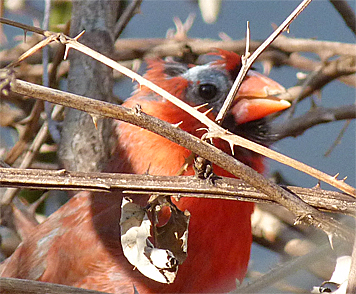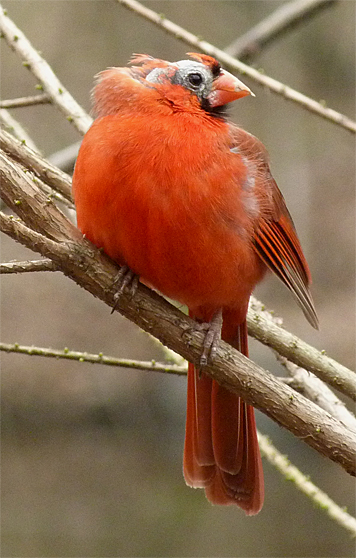
While strolling down the boardwalk into the Wetlands you may have heard the cheery song of a cardinal. If you had stopped to admiral the bright red bird singing from the bare-limbed Bald Cypress on your right, you might have noticed that the bird was balding, or missing feathers from around its eyes and part of its forehead.

The first two photos of the cardinal were shot in mid February. The baldness has progressed since then.
I usually see this kind of feather loss in cardinals during summer, but I first noticed this bird’s problem in February when it began singing from the trees along the boardwalk.
I don’t know why, but this type of feather loss seems more prevalent in cardinals. It may simply be that other birds stay under cover when they experience feather loss such as this. I occasionally see Blue Jays and other birds with no feathers on their heads, but mostly cardinals.
Cardinals usually molt in summer, as do most song birds, long after the nesting season has begun, so its not a normal molt that’s taking place on this bald-headed bird. Besides, molting birds don’t loose all of their feathers at once, it’s a gradual process where the old feathers are pushed out by the new feathers that are coming in. It’s a systematic process.
Most birds do look rather ragged during the summer molt though. But you don’t see a bunch of naked birds running around devoid of feathers during the summer. And, remember, they can’t fly without feathers so they would literally be running around, not flying around, if they lost all of their feathers at once.

So what exactly is causing the feather loss?
The balding on this bird was not caused by hard-living and age, as in my case, but from mites or lice (I’ve had mites and lice before, but not avian mites or lice). I don’t know whether the feather loss is a direct result of the infestation or from the bird literally scratching the feathers off of its head due to the itching caused by the parasites. If you’ve ever had chiggers, you might be able to understand how that could happen.

Why is the feather loss only on the head? Another I don’t know, but I have and idea. The head is just about the only place that the bird can’t reach with its bill to pick off parasites. The bird can certainly scratch its head with its feet though. And as we all know, scratching feels good, but doesn’t get rid of the problem. It usually makes it worse.
I was a bit worried about this bird. Female cardinals choose their mates either by the song the male delivers, its appearance, or a combination of the two. A bright red bird with a nice pointy crest and contrasting black area around its face probably looks pretty attractive to a female cardinal. Our bird lacks those physical characteristics. Obviously, this male cardinal can’t see itself so it doesn’t know what it looks like, but it does keep right on singing, and quiet sweetly I might add.
As I mentioned earlier, this feather loss usually occurs during the summer, long after mates are chosen, nests are built, and young are begging for grub, so you’re stuck with whoever it was that you chose as a mate by the time the feathers fall out (or are scratched out). At that point though, little else matters except for keeping the baby birds fed and protected. They are, both of them, very dedicated parents.
Yesterday, I saw a female in our singing male’s vicinity on more than one occasion, so his singing may be paying off.
I’ll keep an eye on this bird and let you know what happens.
I have a bald cardinal too. The interesting thing is that When his feathers grow back they are black. He ends up looking like a piebald… black and red. Makes me think something else instead of parasites is going on.
A mated female cardinal has been bald for months here in the Twin Cities Minnesota. Today I saw a male cardinal–not her mate–also bald in spots. He sang beautifully, though. But her mate didn’t like him singing in his territory. She, the bald female, has lost all of her tail feathers during egg-sitting season in other years. I wonder whether this baldness has something to do with the sensitivity of the individual bird to some sort of environmental conditions. I hope somebody can give us the definitive answer.
I too, am waiting for a definitive answer.
Thanks,
And still waiting…
I never did locate a nest for this particular bird, though there were many other cardinals nesting throughout our 84 acres.
I found my neighborhood male cardinal friend, whom I’ve been feeding safflower seed and fresh unsalted peanuts for about 3 years, very ill at about 6:30 this evening. He could barely fly. I’m very sad as I think that will be the last time I ever see my favorite bird friend that I’ve gotten to know so well. I’ve developed a personal relationship with this bird for over the last three years, His name is “rojito.” When I used to call him, he would fly over to my home or to me. When I walk by a tree without noticing him, he will do his “chink” common call to say “hi” or to get my attention so that I can then feed him unsalted fresh peanuts that he so loves. He is a very dedicated spouse and father.
I hope Rojito pulls through and lives to see many more nesting seasons.
Thanks,
Thank you for your kind words. I actually saw Rojito’s offspring several townhouses down today and throw him/her ? some pieces of peanut which he/she? happily devoured. Can’t tell whether it’s a male or female at this fledging’s tender age.
These birds look great compared to my frequent feeder. His head is completely black–like a vulture
We have a few flying around here now that have the “vulture” style cut!
I have a bald male cardinal that comes into my yard and feeder daily. I first started spotting him mid to the ending on March of this year. This is the first time I ever saw anything like this and thought at first that he was an old cardinal or molting. Until I found out differently from my mother-in-law who advised me to look up balding cardinals. He appears to be healthy; minus no feathers on his head and he holds his own against the other birds.
Thanks for the input Tracy.
Watched a male cardinal progressively lose the feathers from face and head over the past month. He also seemed to struggle to stay warm, losing weight as he was vigorously pursued by other males. He apparently did not survive the cold 14 hour rain we had in Charlotte this last week. I tried to catch him because of the dropping temperatures & non-stop rain, but he was still flighted, although not getting normal altitude. I hoped to bring him in for care (I am a song-bird rehabilitator) & get a skin scraping to check for mites. I did notice he was much more interested in live food (beetles, meal worms, wax worms) than in seed. Will advise if he returns and if I catch him what the skin scrapings &/or cultures show.
Excellent, I’m hoping the bird is still around and you’re able to catch him and get a scraping to see what might be causing the feather loss.
Found your post on the bald Cardinal while researching a similar bird in my backyard toady. First time I have seen this. It is late February in north east Wisconsin I don’t think it is molting. Take a look http://flic.kr/p/dX6zw4
Nice shot.
No, I don’t think it’s molt either, but so far no one has come up with the definitive answer to what’s really going on.
Thanks,
I am so glad to find this,I watch the birds come to a feeder outside my window..could not figure out why the male cardinal was bald.I was afraid he was diseased.Thank you again.
You’re welcome.
Enjoy the birds!
I noticed a Cardinal with this affliction today. This is the first time I have ever seen a song bird look like this and can certainly say it isn’t normal. In my research I discovered an Ohio DNR article describing the affliction as “conjunctivitis” or otherwise an infection. This article indicates the infection most common to House Finches and is not contagious to humans, dogs, or cats. A relief to me since the birds frequent our dogs food bowls on the deck.
Regardless I felt this information may be helpful to all reading this blog.
The article can be viewed at
http://www.dnr.state.oh.us/Home/ExperienceWildlifeSubHomePage/birdingplaceholder/resourceswbirdsconjunct/tabid/6053/Default.aspx
The contact number in the article is no longer in service as I tried to call them today. I also have no idea how old the article is or when the number was taken out of service.
Best regards!
Thanks for the info.
I don’t think the conjunctivitis, Mycoplasma gallisepticum, is related to what the cardinals and other birds are experiencing with their feather loss. The conjunctivitis actually kills House Finches and it seems to be limited to, or most prevalent in, those birds.
For those who don’t know, House Finches are an introduced species in the east when some of the birds were released in the 1940s in NY. They are native to the Southwest US and Mexico. They were quite abundant here in the east but their numbers are down from what they used to be in the 70s and 80s before sick birds were first noticed visiting bird feeders (mid 90s) here in the eastern US.
We have a few cardinals who are similarly affected. I found this page on the topic on Cornell’s ornithology web site:
http://www.birds.cornell.edu/pfw/AboutBirdsandFeeding/BaldBirds.htm
Even Cornell doesn’t seem to be able to shed any new light on the subject or have anything conclusive say. I find it hard to believe that no one out there has studied this. For years I’ve always thought that it was caused by mites and that the head was the only place that the bird couldn’t reach with its bill in order to pick the mites off.
Hopefully, some day a graduate student will take this problem and solve it once and for all. Until then, I’m sticking with the “can’t reach the mites with the bill theory.”
Thanks,
Found your site after trying to research the blue jay we have coming regularly to our feeder. In the past two weeks or so, it has lost every feather on its head. He doesn’t seem to wander far from our yard. We first noticed him because of how fat he seems to be. Then we noticed his head plumage was gone. We have been watching him daily. He eats well. Hopefully, he stays around long enough for us to see if his feathers come back. It is February, and most of the other blue jays have left our feeder now.
We live in northern Wisconsin.
Thanks for your observations Alice. Although it’s probably colder here in NC this morning (25 degrees at 7 AM) than it is where you are up in Wisconsin, our high today is expected to be around sixty. I don’t know how the birds can maintain their body heat with no feathers on their heads, especially in your area where I doubt it’ll get out of the thirties today. It’d be interesting to know if your bluejay makes it through the rest of the winter.
Thanks, again.
Hi Greg,
I live in Derry, NH and I had one of these birds too land on my deck yesterday afternoon. I was quite taken aback by its looks and gave me another look at this bird. My parents hooked me on birding when I was little and now have several feeders on my deck and once again daily I am propelled back to my child hood and my love for birds.
Thanks for your comments, Mara.
Some of my earliest, and fondest, memories are of watching birds as a child. The fascination that I had for birds then remains with me today.
Thank you for your observations regarding balding birds. This summer was the first time I’ve ever seen balding birds. We have at least 3 balding birds: a grackle, a flicker, and bluejay (1 or 2). The grackle was noticed first about a month ago and he has since improved his appearance with a few feathers, ditto for one of the jays. The flicker was bald as can be, but untouched from the shoulders down. I wonder why it is that the feather loss stops cleanly and evenly at this point in the neck. If the problem were mites or lice that were unable to be picked off by his beak (as you surmise), then one would think that there would not be such a clean delineation at the neck. I’m no expert, but that’s what I’ve observed at my porch feeder (Reading, Mass.).
Thanks for the comments Jenny.
The big question remains, why the head and nowhere else.
I was out today and saw a Blue Jay with the bald head syndrome, a Gray Catbird the other day. Of course, most birds in our area are molting at this time. Even so, they don’t drop all the feathers at once, not even on the head.
I guess more research is needed.
Thanks again,
Have had the same pair of Cardinals in our Minnesota yard for 3 years. Both were banded during their first mating. We observe regularly at close range with 40X-100x spotting scope. Both feed daily from our yard feeding station.
Nov 2010 the male showed feather loss around the right eye and it progressed as in your pictures. By March (thru a lot of very cold weather) he was completely bald to the bottom of his neck. They remained paired all winter. Spring 2011, he defended his territory against newcomers and they nested successfully.
By May 2011 feather loss has continued slightly down back & further down the chest. He spends his spare time in a brush pile a few feet from our kitchen window where he preens and rests. He baths daily in a bird bath. I have never once seen him attempt to scratch.
Behaviorally he acts like a normal Cardinal. He survived a long severe winter and a prolonged very wet spring. He often appears completely drenched. Think of the stress from heat loss all winter, exposure to weeks of cold wet skin & UV exposure & sunburn.
I have to disagree, I do not believe this is a common occurrence. The bird went through a normal molt during the summer of 2010. It was several months after molting that feather loss began. Nor is this bird recovering; rather the condition is worsening. The female shows no signs of abandoning him. If it’s caused by mites or lice, one might think that he’d shed a few on the nestlings when brooding or feeding them. I’ve scoured the surrounding area for signs of other affected cardinals–none. Lastly, why is it that only males are afflicted? Through 60 years of very active bird watching this is the first time I’ve witnessed this.
Interesting observations.
As mentioned in the post, I do think it is a common occurrence but not a normal one, and not related to molt. I don’t know what the cause is but it doesn’t seem to be molt.
I agree, the heat loss in winter and heat gain in summer must have a negative effect on the birds, but it’s not apparent to me.
The feather loss doesn’t seem to be a problem with finding a mate, but I don’t know exactly what the birds experience in their quest for mates. There’s probably many things missed by us humans that only the cardinals know about, what they look for in a mate, how many females reject the males before a suitable mate is found….
There’s a photo of a female with the malady taken by Cathy and Tracey Trumbull on Knoxville, TN: http://photosrus2008.blogspot.com/2011/04/bad-hair-day.html – scroll down to the bottom of the page.
Great observations, and thanks for the comments.
My children and i found your your march 18 post on the bald headed cardinal and we all appreciated his story. Your site was the first to come up when we googled “what causes cardinals to have a bald head” for we have one of these little friends coming to our bird feeder the last couple of weeks. We have seen him a lot and sometimes he is with his lady. But we want you to know a story of how he is a very dedicated parent. Today he brought his two little girls with him and while his lady ate, he fed his two fluffy, shivery daughters. He picked up skattered seeds and fed each one as they opened up their mouths for him. Needless to say we were amazed and thankful to see such tenderness. In our years of having this feeder on our deck we have never witnessed such a scene. Now the second part of the story : another male came along and was very agressive toward our bald male who backed off. Then this same cardinal male started pecking at one of the baby girls and dad took action immediately diving at this arrogant bird and chasing him away.
We look forward to seeing them again.
Also we have been blessed with at least one painted bunting couple coming to our feeder. We just discovered the existence of these lovely creatures this week.
As for you Ranger Dodge, the hairs on your head are all numbered by the Heavenly Father and not one of them falls without him knowing it, and as the Lord Jesus says, not one sparrow falls to the ground without him knowing it, how much more does he care for you!
Thank you for your post.
Sincerely from Oak Island, NC
Thanks for this info. I’m in Austin Texas and we have MANY cardinals at our feeders. Today I saw a grown male with his head feathers and crest almost completely gone. Maybe its mites. I was worried that our bluejays were beating up the other birds. I also found a dead little finch a week ago so thought maybe incidents related but I guess just coincidence. We live by preserve wooded area. Keep feeders on the edge, it’s great bird watching!
Thanks for the comments and information.
I haven’t been to Austin in quite a while, good birding in that part of Texas, but I guess all of Texas has some good birding!
If I found a dead finch (House Finch?) at my feeder back east here I would suspect Mycoplasmal Conjunctivitis as the cause of death. Has that disease hit the Texas Hill Country?
Thanks again.
Hi –
I just found a male balding cardinal – but I think it is the same Mr. Cardinal that has been hanging around my house for the last three years.
He lost his feathers around his eyes and, upon searching, found this post! I live on Waterman Lake in Glocester, RI and was wondering. I”ll keep my eye out for my balding cardinal too.. 🙂
Hey Cathleen.
It seems to be a common occurrence in cardinals (loosing the feathers on their heads) as well as a few other species.
Do you have many cardinals around your place? It wasn’t too long ago that a cardinal was a rare sighting in RI.
Have a good one.
Oooo- I found an interesting article that might explain why it might be common:
http://www.acsu.buffalo.edu/~insrisg/nature/nw98/baldbirds.html
Don’t know if its true but makes sense 🙂
Thanks Courtney. I agree with both Mark and Susan at Hawk Mt. and Mohawk, respectively at the above URL. The birds always seem to recover, and yes, it’s tough to pick off parasites from your head using your bill. A pair of hands, or even a mate to help with the preening would be a good thing to have. That is of course, if the problem is parasites and not a molt that’s specific to individual birds.
I’ve read other reports where banders have seen this baldness and have never actually found any mites on the bird’s head, but as Liz Day, Indianapolis, IN suggested “…Perhaps the mites left the head after the feathers were all gone and moved to the neck?” Who knows what’s really going on. It may be a combination of molt and parasites as suggested by some. It also seems to occur in some species more than others.
One thing about the molt, cardinals should already be in their alternate (breeding) plumage by the time the mating season rolls along, the better to attract a mate. But hey, I guess things don’t always happen when they’re supposed to.
One thing’s for sure, the birds look rather prehistoric, dinosaur prehistoric that is, without feathers!
We saw this a bunch at the wildlife hosptial and I was told it was a common way for Cardinals to molt into and out of the mating season. So I wouldn’t worry- it’s not the only bald-headed cardinal around 🙂